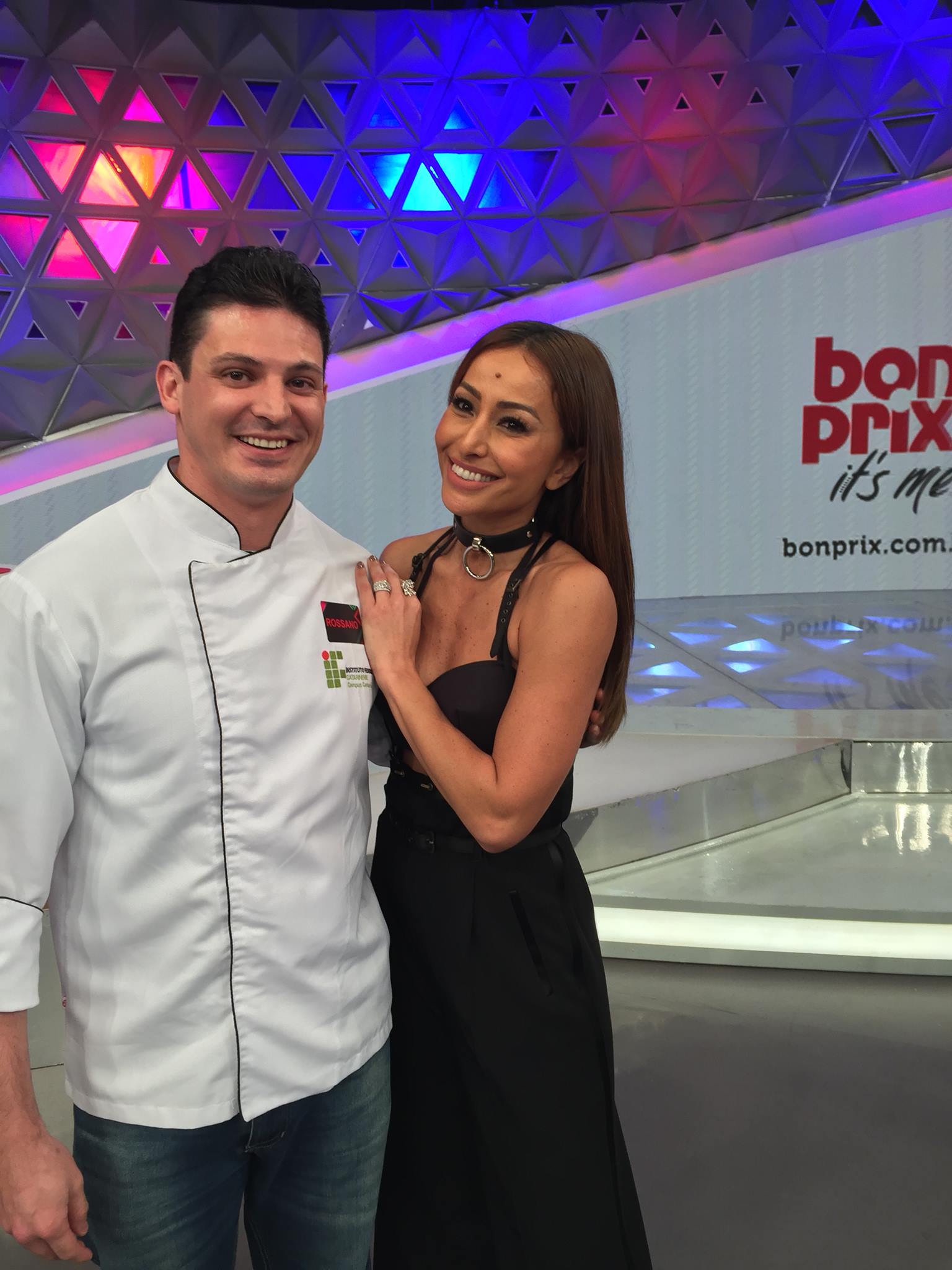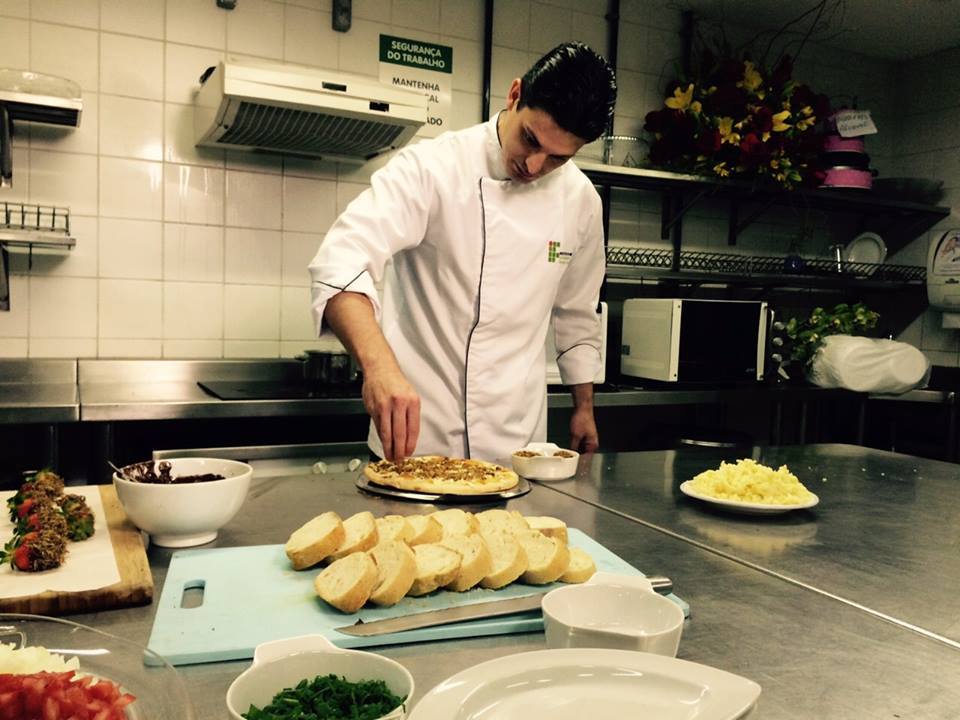 Rossano Linassi is a young and solar brazilian chef who realizes delicious dishes with insects, participates in many TV shows, conferences and workshops. I contacted him and we have a long intercontinental chat conversation about edible insects and gastronomy. His enthusiasm is contagious and in few messages he involves you in his amazing reality!
Rossano Linassi is a young and solar brazilian chef who realizes delicious dishes with insects, participates in many TV shows, conferences and workshops. I contacted him and we have a long intercontinental chat conversation about edible insects and gastronomy. His enthusiasm is contagious and in few messages he involves you in his amazing reality!
How this passion for edible insects has started?
I had my first contact with edible insects through the boy scout survival workshop group, more or less in 1998-99.
The first contact is always a little bit difficult and generates fear but, in the midst of context, I can say that it was even smooth, it occurred naturally (eating insects when you are in a group of young people is easier).
Professionally, everything started with an article for a gastronomy class in 2004 (when I was a student), but took power in 2008 with the invitation of Biologist Prof. Eraldo Medeiros Costa Neto, who has greatly helped the development of Entomophagy in Brazil, to participate in the first symposium on the subject in city of Feira de Santana, Bahia.
Thereafter I increased my research participation, writing a chapter of a book (“Antropoentomofagia: insetos na alimentação humana – Entomophagy: insects as human food – first of its kind in Brazil).
I participated in the “programa do Jô” (a very famous talk show in Brazil) that eventually opened many opportunities to talk about antropoentomophagy and cooking some bugs, culminating with many participations in TV shows, newspapers, magazines, workshops and conferences.
Much of this TV material can be found in a youtube channel where I recently gathered some videos.
Are you in conctat with farm, industries or other players in the edible insects industry?
I have contact and visited some of the bio-factories.
In Brazil this is still a starting business and so few companies are producing insects in large quantities. I can name three of those: “Nutrinsecta” from Minas Gerais (Mr. Otavio Possas), “Qbiofábrica” in São Paulo (Ricardo Braga and Casé Oliveira) and “Insetos Brasil” in Pernambuco (Ginaldo Menezes). Them all produce about 2 tons per month and sell most of the production as animal feed (for reptiles and birds) and just a little part goes to human consumption.
Do you breed insects yourself?
I do not breed insects but I buy them from three farmers I know and this facilitates the purchase and partnership between us.
I know also Gilberto Schicker, zootechnist, who is currently developing a startup of insects and cereals bars and teaches in courses giving advices for new breeders.
Another initiative in Brazil is the creation of the Association of insects breeders (ASBRACI), whose main aim is to facilitate the communication between breeders and consumers and developing the relation with the Government, seeking for regulations for the sector.
What are normative framework in Brasil? Are there some specific laws?
We have no specific laws on the subject in Brazil, which makes the industry work without determined legal framework, but breeding/selling edible insects is not illegal.
The biggest challenges in Brazil are mainly the lack of legislation that specifically allows human consumption, the lack of laws about their trade and no specific legislation about food security in insects products; unfortunately these things hinder the spread of this practice.
Researches in the area and the development of technologies for mass production of other insect species are hampered by lack of incentives and high costs.
A second point is certainly that we need more studies “to convince” the people that insects consumption is beneficial and does not bring health risks.
It is very important to create a network of researchers and chefs around the world, working with this theme to deepen the studies and promote entomophagy.
Do you think entomophagy is only a “food fashion trend” or do you really believe in its potential?
Nowadays even the FAO-UN classifies insects as food.
I think that edible insects are today in the same condition sushi was 20 years ago.
In my opinion, insects are not a substitute for the so-called “normal meat”, but another food option with high nutritional qualities that can be easily incorporated into regular diet of whole population in normal meals and not only as a supplement or complement or substitute.
Insects, with a slightly longer period (due to restrictions and cultural barriers), can be gradually incorporated in regular diets, becoming popular and gaining adherents as are better known and tasted by the public.
There are more than 1 million known species of insects (now about 2000 catalogued as food). We’ll find new flavors, aromas and textures that are to please the most demanding and curious palate.
In which ways do you valorize insects? What kind of food do you pair them with?
What seems to us “tasty” or “edible” is influenced from several factors as social, cultural, historical, geographical and many others…that’s why a food is acceptable for some and it’s not for others. For example, consumption of oysters is widely accepted along the coast but refused in the inland.
Insects are very tasty for someone and prohibited or disgusting for others.
What I want to point out with the examples is that everything depends on the reference and behavior.
It will certainly be easier to educate future generations and show them that these are tasty “new” foods than trying to convince the older generations.
Thus the more chefs, cooks and cooking enthusiasts use insects as food, the faster will be their acceptance in various social classes… just taking this exotic ingredient and adding it to regular food. Active participation in this re-discovery is essential for bugs-gastronomy development, gaining more fans and usual consumers.
We can also re-invent regional dishes (are abundant in Brazil and around the world) with adding insects. Otherwise we should also create new dishes and not only re-invent dishes just changing the protein.
Insects are very versatile and can be used with both sweet and savory dishes, the rest of it depends on the creativity and inventiveness to propose new compositions, flavors and beautiful presentation…and of course discovering the insect flour, because this reduces drastically the visual impact.
What do consumers say?
Explaining the taste of different insects or comparing them is really difficult because of their light nuances and flavors combinations and unique taste, often quite complex and interesting. Wild insects have a pronounced and stronger flavor while farmed insects are more neutral, but they both usually get the flavor of the spices we use for cooking them.
For me the greatest resistance occurs because insects are seen as harmful or vectors of disease, as the case of cockroach, actually there is a prevalence of negative psychological aspect than the positive idea of their taste or aroma.The simplest insect are the larvae, that have mild flavor of cereals or almonds, and are very palatable. Crickets with chocolate are more easily accepted, they have a great taste, also resembling a chocolate cookie. Very interesting are the “tanajura or Içá” (big ant from Brazil) which has a unique complex flavor, slightly acid with an earthy touch.
Insects are directly influenced by what they eat and that is very interesting in the food production; this is more noticeable in the larvae than in the adults, that end up with a more distinctive flavor not dependent on the food they were fed.
All these aggregate flavors make insects have more complex aromas that contribute to more interesting and palatable dishes. We still need to move forward with further tests and perhaps even make the final feed (just before slaughtering) with herbs and spices, seeking more nuances and flavors and surely raising the level of the dishes.
Certainly showing the whole insect is important to make people “believe” their consumption is possible, but they are more easily consumed if they are disguised, such as using insect flour.
Insects are not a substitute for any kind of meat, nor make claims to eradicate hunger in the world, but to be a new food-plus, a new food-option for all social classes.
Did you notice some allergic reactions or other problems?
I don’t know a single person who has suffered allergies or other reactions to insects (except psychological ones), but we always advise caution to people that are allergic to seafood, because the chemical composition is very similar in both of them.
What are your best dishes?
Usually I cook dinner for my friends with crickets or larvae and all of them appreciate a lot and are enthusiastic, even if some of them still have a little fear in eating bugs.
My favorite dishes are with tanajuras, that are good both sweet and savory.
I like the oriental cuisine and my dishes have that touch.
I think the risotto was also very interesting. But crickets with chocolate are fantastic!






